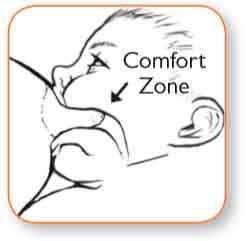
Sore Nipples & Engorgement
Tender nipples and breasts can occur during the early weeks of breastfeeding. Here are some ways to increase your comfort so you can enjoy this time more.
Sore Nipples
What causes sore nipples?
Sore nipples can happen anytime, but most often the first 1-2 weeks after delivery. It can vary from mild to severe soreness depending on the individual. Some discomfort can happen the first minute or two of breastfeeding as your baby pulls the nipple into the right position. This is normal, but soreness after the first minute or two is not. The most common cause of soreness after the first few minutes is poor positioning and/or a poor latch. Other causes may include: breast engorgement, infection, sensitivities to nipple ointments or creams, misuse of nipple shields or breast pumps.
Can I prevent sore nipples?
Yes. The best way to prevent sore nipples is to help your baby latch on the right way. Remember these tips:
- Bring your baby to you with a wide open mouth.
- Sandwich your breast in a C or U-hold to help your baby take a deep mouthful of your nipple and areola.
- Aim you nipple up towards the roof of your baby’s of her mouth towards the comfort zone (shown below).

You may also find that using breast creams such as Lanolin may help relieve any current discomfort and/or prevent it from occurring in the first place.
How do I know my baby is latched on well?
Here are some signs that your baby has latched well:
- You feel a tugging painless tugging, rubbing or pinching feeling while breastfeeding. Some discomfort the first minute or two when your baby first latches can be normal the first few weeks.
- Your baby’s lower lip is rolled out.
- Your baby has most of your areola in their mouth.
- Your baby’s chin is touching your breast and there is a small space between their nose and your breast
How can I help the soreness go away?
- Identify and fix the cause of your sore nipples. Get help from a lactation consultant to help you figure out why you are getting sore.
- Soothe your sore nipples by applying:
- Expressed breast milk
- An ointment for sore nipples that states it does not need to be removed before breastfeeding (Such as our lanolin). Apply only a thin layer to the nipples after breastfeeding.
- Applying protective breast shells to your breast to care for your nipples between breastfeeding and/or breast pumping sessions.
Engorgement
What causes engorgement?
Engorgement happens when the breasts become swollen from infrequent, delayed or missed breastfeeding sessions (or pumping sessions if your baby doesn’t breastfeed). Engorged breasts can be hard, painful, red and hot to the touch. Keep in mind, most women experience some breast fullness in the first 2-3 days after their baby is born. This fullness happens as your milk volume increases, Do not confuse this with engorgement.
Can I prevent engorgement?
Yes, here are some ways to prevent engorged breasts:
- Breastfeed right after your baby is born.
- Breastfeed on demand when your baby is showing hunger cues. This will be about every 2-3 hours, Do not skip feedings at night.
- Breastfeed on one side as long as your baby wishes to help drain your breast well. Listen and if you hear swallows, let her keep sucking on that side. If your breasts feels less full and you cannot hear swallowing any longer, offer the other side. They may or may not want more.
- Begin each feeding with the breast they drained the least. Usually this is the side she breastfed the least amount of time on.
- Avoid delaying or missing a feeding and avoid supplementation.
- Avoid wearing bras that are too tight.
- If you are pumping for your baby who cannot breastfeed yet:
- Start pumping as soon as possible, within 6 hours of your baby’s birth.
- Avoid missing a pumping session.
- Make sure to drain your breasts well by massaging your breasts before and during pumping. Make a habit of doing hand expressions after each session.
How can I help engorgement go away?
It is important to treat engorgement before it gets too painful. Severe pressure and swelling can cause breast tissue damage. Here are some ways to help:
- Apply cold after breastfeeding such as ice packs or a bag of frozen peas wrapped in a wet cloth work well. Some mothers find that cold, raw, clean cabbage leaves provide relief. If using cabbage leaves, rinse before using. Place the cabbage leaf in your bra for 15-30 minutes two to three times a day. Avoid cabbage if you are allergic to it or develop a skin rash.
- To make milk flow easier:
- Gently press on the areola with the pads of your fingers, in towards your breast for a minute or two. This will help soften the areola so your baby can latch easier.
- Hand express or pump to start the milk flow.
- Gently massage your breasts.
This is general information and does not replace the advice of your healthcare provider. If you have a problem you cannot solve quickly, seek help right away. Every baby is diff erent, if in doubt, contact your physician or other healthcare provider.
References
Mohrbacher N. Breastfeeding Answers Made Simple: A Guide for Helping Mothers. Amarillo, TX: Hale Publishing, LP; 2010.
Spangler A. Breastfeeding: A Parent’s Guide. 9th ed. Cincinnati, OH: Specialty Lithographing Co; 2010.
